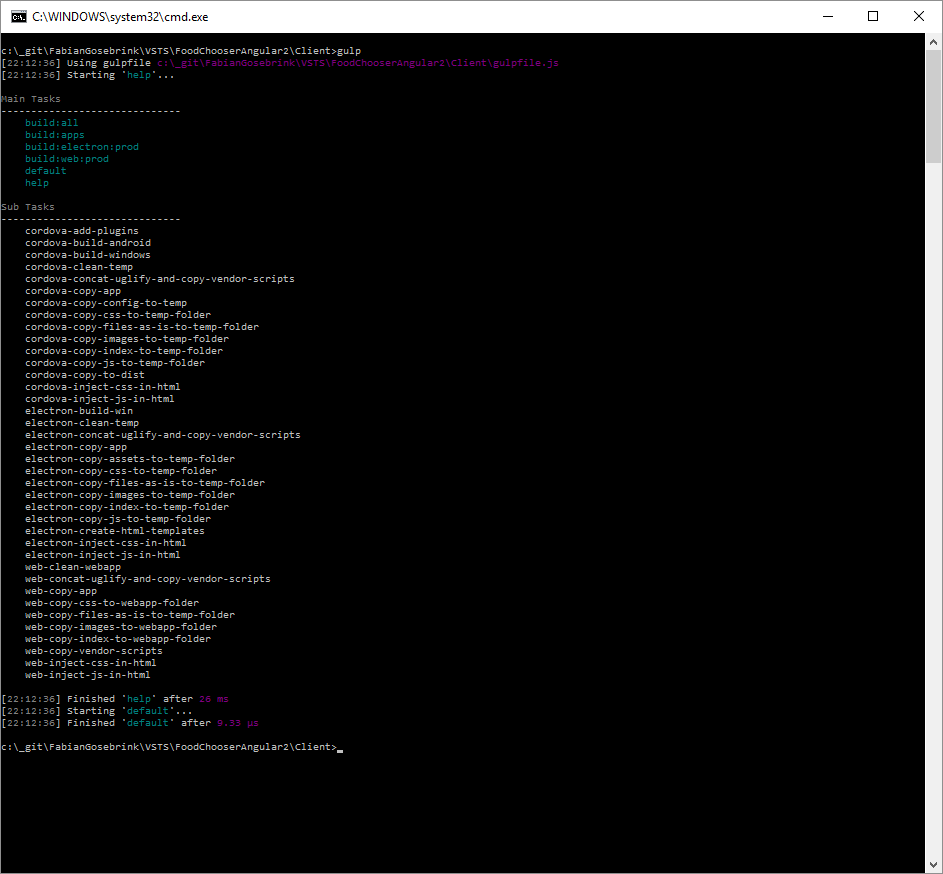How You Can Organise Gulp in Your Applications
In this blog post I want to show one possibility of organising your gulp tasks in a way that you as a developer can find them quickly and print them to the console in an ordered way.
I have taken all these examples from my cross platform examples on GitHub. Especially from Foodchooser.
Motivation
No matter what you do with web development today you will have to have a task runner when it comes to distribute to a customer at the latest.
Gulp is one task runner which it makes easy to fulfill all then tasks like concatination and uglify-things we actually need to reduce request and optimize our performance etc.
But we as developers have also different tasks to face: We want a web application in dev-mode for our development environment. But we also want to have a distribution-ready environment for our staging and test environments etc.
When you are heading towards cross platfrom development this thing is even more important. Because your outputs differ from a webpage only with an additional executable (electron) and mobile apps for your phones.
Organising your files
Gulp and its config
I think the best practice here is to seperate gulp itself on the one hand and the paths to the files and folders on the other in different files.
The gulpfile.js only contains the tasks whereas a file named like gulp.config.js is containing all your files, (temp-)paths, … .

You can include your config file in the gulpfile like this:
var buildConfig = require('./gulp.config');
If the files are on the same level.
The gulp.config.js can look like this:
module.exports = {
general: {
appName: "FoodChooserAppAngular2",
rootFolder: "app/",
indexHtml: "./index.html"
},
sources: {
sourceFolder: "src/",
allAppJsFiles: [
"./app/*.js",
"./app/*/**/*.js",
],
allAppHtmlFiles: [
"./app/**/*.html"
],
allVendorJsFiles: [
"./js/*.js"
],
allAppCssFiles: [
"./node_modules/bootstrap/dist/css/bootstrap.min.css",
"./css/*.css"
],
allAppImgFiles: [
"./img/*.*",
"./img/windows/*.*"
],
vendorScripts: [
"node_modules/zone.js/dist/zone.js",
"node_modules/reflect-metadata/Reflect.js",
"node_modules/systemjs/dist/system.src.js",
"node_modules/jquery/dist/jquery.js",
"node_modules/bootstrap/dist/js/bootstrap.js"
],
// ...
},
// ...
targets: {
webAppOutputPath: "../.dist/webapp/",
electronOutputPath: "../.dist/electron/",
cordovaOutputPath: "../.dist/cordova/",
};
It is only containing all the files, paths and general information you want to use.
The gulp-file itself is now only containing the tasks and is consuming the config file.
gulp.task('web-copy-index-to-webapp-folder', function (done) {
return gulp
.src(buildConfig.general.indexHtml)
.pipe(gulp.dest(buildConfig.targets.webAppOutputPath));
});
This makes the gulp tasks more generic.
Tasks in folders
I’ve seen many ways how people organise the gulp tasks but it turned out for me it was the best way to have a folder called “gulpTasks” (or similar) where I put all my gulptasks in. I’ve seen this on many other repositories and also on conferences etc. It’s always good to have a folder encapsulating all your gulpTasks like this:

Here I seperate all the different systems I want to have an output for.
But that also means, that the task seen above is moving to the web.js file.
How do I build up the “architecture” for my gulp-tasks now?
Manage your tasks
Well we have to go one step back before clarifying how to solve this:
Getting an app ready for distribution or even for development purposes is more than one task. Although I know the task-dependency-system in gulp where all the dependent tasks are executed in parallel before the called task is going to run I think it’s easier to run the things in sequence. It’s easier to read and easier to maintain IMHO.
Therefore you need to install a run-sequence-plugin available here. With this you can divide your tasks and seperate the responsibilities in your web gulpfile (e.g.) like this:
var gulp = require('gulp');
var runSeq = require('run-sequence');
gulp.task('build:web:prod', function (done) {
runSeq(
'web-clean-webapp',
'web-copy-index-to-webapp-folder',
'web-copy-images-to-webapp-folder',
'web-copy-css-to-webapp-folder',
'web-concat-uglify-and-copy-vendor-scripts',
// all the other tasks
done
);
});
I think this is a very good and clear documentation of what is done if I call the main task.
As a tip: I do also use this for “debugging” when something is going wrong. I can easily comment out the single tasks and the which one is causing trouble
What we also did in this step is: We defined a main task! This task can be referenced and executed from the main gulp file.
require('./gulpTasks/web');
//...
gulp.task('build:all', function (done) {
runSeq(
'build:web:prod',
// maybe other main build tasks
done
);
});
You can repeat that for all your files and main tasks.
I recommend to have 2 main tasks per file at the maximum: Dev and Prod.
So here we are building a small architecture and get some order in our tasks-, file- and folder-structure.
The default tasks
Often I see that the default task is executing logic. It does something. And when the default task is doing something it’s most likely something like a main task. Like “build-all” or something?
Let’s picture the situation you cloned a repository and you want to get started. Thats all you want to do. First step: “Let me see what you have got for me”.
If you run gulp which executes the default task and something starts to run and I as a developer have NO IDEA what exactly runs there – that scares me.
Wouldn’t it be better to have a kind of more defensive behavior? This is why I prefer to list all the tasks the repo offers to the developer. And the developer can then decide which one he wants to execute.
But with this option I mentioned above we have many small tasks which can be executed.
This is why I do name the tasks in a special way:
All main tasks are divided with a “:”, all child tasks with “-”.
For the task-listing feature there is also an npm package available here.
“gulp-task-listing – Adds the ability to provide a task listing for your gulpfile”
You can define filters to define which one is a main task and which one is a child task.
var taskListing = require('gulp-task-listing');
//...
gulp.task('help', taskListing.withFilters(/-/));
Everything we need to do now is to point the default task on this help task to list all the tasks:
var taskListing = require('gulp-task-listing');
//...
gulp.task('default', ['help']);
gulp.task('help', taskListing.withFilters(/-/));
Which brings the following output:

Further steps
common.js
One possibility would be going along and define some “main”-tasks and be more generic which can be executed from the web.js and other files. Like a common.js containing generic tasks like:
function copySourcesTo(targetFolder) {
return gulp
.src(getSourceFiles(buildConfig.source.folder), {
base: buildConfig.source.folder,
})
.pipe(gulp.dest(targetFolder));
}
function copyFromTo(sourceFolder, targetFolder) {
return gulp
.src(path.join(sourceFolder, '**', '*.*'))
.pipe(gulp.dest(targetFolder));
}
function cleanTemp(done) {
del(buildConfig.targets.tempFolder).then(function () {
done();
});
}
//...
For tasks which are all the same in every step. Perhaps this can be useful
I did this in this repository here
Prefixes
You could also prefix your private tasks with a “[private]-…” tag or something to clearify in the task overview that this task should be private.
Conclusion
I hope with this post I could give you a small idea of how to treat your gulp files and tasks in order. Keep them seperated and let them have single tasks to do. I think with this you can keep also a big system organised.
Links
https://github.com/FabianGosebrink/ASPNET-Foodchooser-Cross-Platform-Angular2
https://github.com/FabianGosebrink/ASPNET-WebAPI-AngularJs-XPlatform-Example
https://www.npmjs.com/package/run-sequence
https://www.npmjs.com/package/gulp-task-listing









